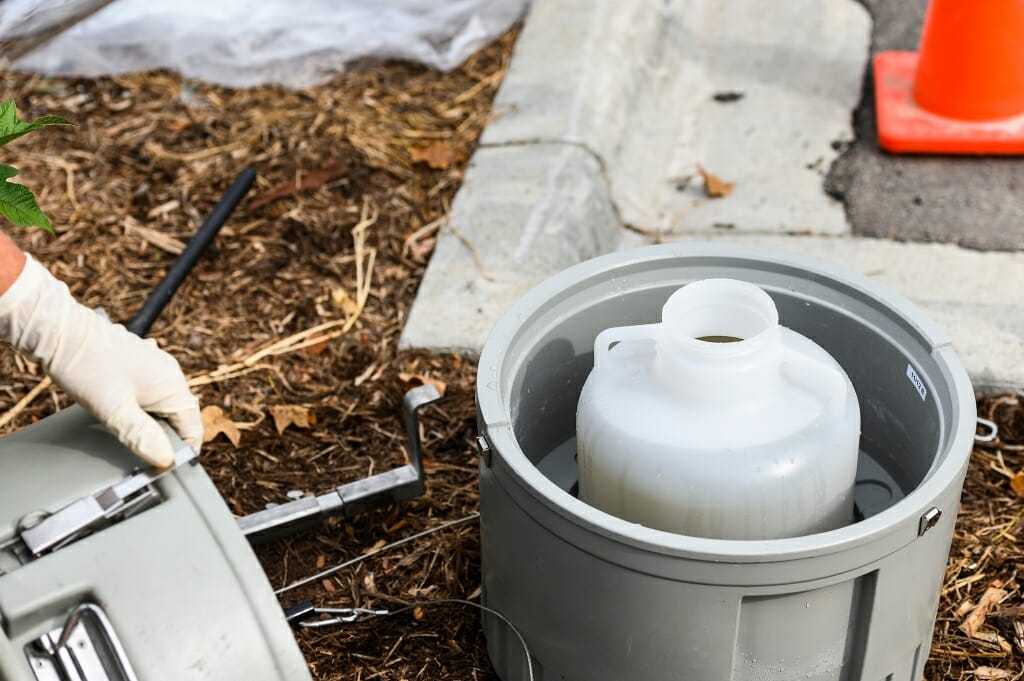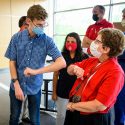Wisconsin named National Center of Excellence for wastewater surveillance

Wastewater is removed from a sampler for wastewater sampling, in a site on campus. Photo: Jeff Miller
The Centers for Disease Control and Prevention has named the Wisconsin Wastewater Surveillance Program a National Center of Excellence for wastewater surveillance within the National Wastewater Surveillance System (NWSS). Wisconsin joins just three other CDC NWSS Centers of Excellence in the country.
The Wisconsin Wastewater Surveillance Program is a partnership between the Wisconsin Department of Health Services, the Wisconsin State Laboratory of Hygiene at the University of Wisconsin–Madison, and the University of Wisconsin-Milwaukee School of Freshwater Sciences. The Wisconsin Wastewater Surveillance Program was an early pioneer during the COVID-19 pandemic in developing and applying wastewater-based surveillance for SARS-CoV-2 and is recognized as a national leader in wastewater-based monitoring of human pathogens.
Community-focused wastewater surveillance is a cost-effective tool for public health practice. It involves looking for the presence of pathogens that people shed in sewage, whether or not they have symptoms, and measuring the pathogen levels over time. Individual testing is not required, and it does not depend on individual access to a healthcare or testing location.
By screening for pathogens in untreated wastewater at a given central wastewater treatment facility, wastewater surveillance can help determine whether infections are increasing or decreasing in the community served by that facility and provide early warning about the spread or prevalence of disease. This can help public health agencies engage in prevention efforts where they are most needed and complement other data that public health agencies collect with respect to disease spread.
“The great value of wastewater-based pathogen surveillance as a complementary tool to traditional disease prevalence monitoring was clearly demonstrated during the COVID-19 pandemic,” says Martin Shafer, senior scientist and a program director at the WSLH. “Everyone can now simply click a web link and bring up dashboards displaying near real-time data and maps of the levels of SARS-CoV-2 in hundreds of communities across the country.”
As a Center of Excellence, the Wisconsin Wastewater Surveillance Program will offer subject matter expertise and provide training, consultation services and resources to public health agencies and affiliated laboratories, including those looking to start surveillance programs and those advancing existing monitoring programs.
It will also offer critical support to the National Wastewater Surveillance System to explore innovative approaches to identify pathogen variants and strains, evaluate novel strategies for early warning of disease outbreaks and provide proficiency testing services to laboratories across the country conducting wastewater surveillance.
The Wisconsin Wastewater Surveillance Program officially launched in September 2020, monitoring SARS-CoV-2 levels in wastewater from over 70 wastewater treatment facilities across Wisconsin, reflecting contributions from over 50% of the state’s population. The Wisconsin program was one of six in the initial cohort that formed the National Wastewater Surveillance System, which has grown since 2020 to include over 60 programs across the nation.
“None of this would be possible without the voluntary participation and partnership of the wastewater treatment facilities,” Shafer says.
Currently, the WWSP monitors wastewater for SARS-CoV-2 levels from nearly 50 Wisconsin facilities and a subset of facilities for influenza viruses and RSV. In addition, the program is using advanced gene sequencing approaches to identify specific SARS-CoV-2 variants in the wastewater.
Wisconsin SARS-CoV-2 wastewater surveillance data can be found on the DHS website and genetic sequencing data is available on the WSLH’s wastewater genomic dashboard.
Tags: awards, health & medicine



